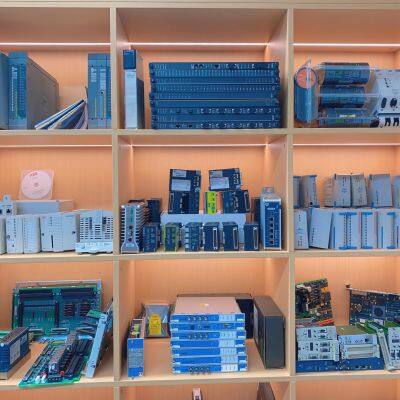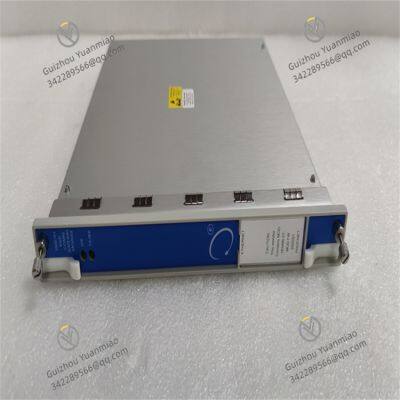Product Description
I. Overview
BENTLY 3500/91 is a communication gateway module that holds a pivotal position in the field of industrial automation and equipment monitoring. Leveraging Bently Nevada's profound expertise in mechanical monitoring and industrial communication technologies, this module provides solid communication guarantees for the efficient operation of various industrial systems. It mainly serves industrial equipment monitoring systems, especially working closely with the BENTLY 3500 series monitor systems, aiming to achieve efficient transmission of equipment operating data and system integration. It ensures the stable operation of industrial equipment, such as large rotating machinery like steam turbines, generators, and compressors. Through precise data communication, it offers key data interaction support for equipment fault diagnosis, performance optimization, and preventive maintenance, effectively enhancing the reliability and safety of industrial production processes, and reducing the risk of equipment failures and production losses caused by poor communication or delayed data transmission.

II. Technical Parameters
(1) Physical Specification Parameters
Dimensions: The module features a compact design with external dimensions of 241.5mm in height (9.50 inches), 24.5mm in width (0.96 inches), and 242mm in depth (9.52 inches). Its small size allows it to be flexibly installed in limited - space locations such as various equipment control cabinets and monitoring racks, easily adapting to different industrial installation environments. It enables efficient layout in limited space without hindering the installation and layout of other equipment, greatly facilitating system integrators in system construction and space planning.
Weight: It weighs only 0.79kg (1.75 pounds). The lightweight feature makes it easy for workers to carry and operate during equipment installation, maintenance, and inspection, significantly reducing labor intensity and improving work efficiency. Meanwhile, the low weight requirement also reduces the load - bearing pressure on the installation structure, enhancing the flexibility in choosing installation positions.
Shell Material: The shell is made of robust and durable high - strength alloy material. This material has excellent impact resistance, which can effectively resist common mechanical collisions and scratches in industrial sites, ensuring that the module is not easily damaged physically in complex industrial environments. In addition, it also has good corrosion resistance and high - temperature resistance, which can provide reliable protection for internal precision electronic components in harsh environments such as humidity, dust, and high temperature, prolonging the overall service life of the module and ensuring its stable operation in various complex industrial scenarios.
(2) Power Supply Parameters
Power Supply Voltage: It adopts a 24VDC DC power supply mode. This voltage specification is compatible with the power supply systems of most industrial sites and can adapt to voltage fluctuations within a certain range. In actual industrial applications, even if there is some instability in the power supply voltage, as long as it is within a reasonable fluctuation range, the module can maintain a stable working state, continuously providing reliable power support for the communication and transmission of equipment monitoring data, and ensuring the continuity and stability of data transmission.
Power Consumption: Under normal working conditions, the power consumption is at a low level. The typical power of the Modbus RS232/RS422 I/O module is 5.0 watts, and that of the Modbus RS485 I/O module is 5.6 watts. The low - power characteristic not only conforms to the development trend of energy conservation and emission reduction in the industrial field, helping to reduce energy consumption costs, but also reduces the heat generated by the module itself due to electric energy conversion, avoiding problems such as performance degradation and faults caused by overheating, further improving the stability and reliability of the module's operation, and ensuring that it can work continuously and stably for a long time.

(3) Communication Parameters
Communication Interfaces:
Ethernet Interface: It supports 10BASE - T and 100BASE - TX (twisted pair) Ethernet connections in accordance with the IEEE 802.3 standard, with an RJ45 interface type. The Ethernet interface has high - speed data transmission capability, providing a convenient way for the module to connect to the industrial Ethernet network, and enabling fast real - time sharing and remote access of monitoring data. In large - scale industrial sites, equipment monitoring data can be efficiently transmitted to remote monitoring centers, factory information management systems, etc., through the Ethernet interface, meeting the needs of equipment monitoring and control scenarios with high real - time requirements, and improving the intelligence and informatization level of equipment monitoring.
Communication Protocols:
Modicon Modbus Protocol: It supports the use of the Modicon Modbus protocol through serial communication interfaces. This protocol is widely used in the field of industrial automation, with good universality and compatibility. Through the Modbus protocol, the module can exchange data with many devices and systems that support this protocol, facilitating the interconnection and intercommunication between devices from different manufacturers, and promoting the integration of industrial systems.
Data Transmission Rate: The data transmission rate of the Ethernet interface can reach up to 10Mbps, which can meet the needs of fast transmission of a large amount of equipment monitoring data. In actual industrial applications, the transmission rate can be flexibly adjusted according to the specific network environment and data traffic requirements to ensure the stability and reliability of data transmission. Whether in scenarios such as real - time monitoring of equipment operating parameters, rapid upload of fault diagnosis data, or issuance of remote control commands for the system, the high data transmission rate can ensure the timeliness of information interaction, providing strong support for the efficient operation and management of industrial equipment.
(4) Environmental Adaptability Parameters
Operating Temperature Range: It has a wide operating temperature range and can work stably under extreme temperature conditions from - 40°C to + 85°C (- 40°F to 185°F). Whether in cold northern industrial plants, hot southern high - temperature workshops, or industrial facilities in high - temperature environments such as deserts, the module can operate normally, maintaining stable communication functions, ensuring the reliable transmission of equipment monitoring data, not being interfered by temperature factors, and providing communication guarantees for the continuous operation of industrial equipment in various complex temperature environments.
Humidity Adaptability: It can operate stably in an environment with a relative humidity of 10% - 90% (non - condensing). The interior of the module adopts special moisture - proof treatment processes, such as applying moisture - proof paint to the circuit board and designing sealed interfaces, which effectively prevent short circuits, corrosion, and other damages to the internal circuit caused by humid air. This enables the module to operate reliably in high - humidity environments such as humid coastal industrial areas and chemical workshops, ensuring the stability of data communication and the service life of the module, and being suitable for industrial application scenarios with various complex humidity conditions.

III. Functional Features
(1) Powerful Data Communication and Integration Capability
High - speed Data Transmission Ensures Real - time Performance: The Ethernet interface with a data transmission rate of up to 10Mbps and the use of a high - speed internal network enable the module to quickly collect time - stamped current measurement values, module status, current alarm status, and other information from other modules in the rack, and transmit these data to process control and other automation systems at an extremely fast speed. In the process of monitoring equipment operating status, real - time performance is crucial. Fast data transmission allows operators to obtain the latest status information of the equipment in a timely manner, quickly respond to abnormal changes of the equipment, strive for valuable time for timely maintenance and fault prevention of the equipment, and effectively improve the safety and reliability of the industrial production process.
Comprehensive Data Integration and Sharing: Through its rich communication interfaces and strong protocol support, the module can comprehensively integrate the monitoring values and status information of all modules in the 3500 rack, and efficiently share these data with factory information systems, such as distributed control systems (DCS), programmable logic controllers (PLC), or human - machine interfaces (HMI). This comprehensive data integration and sharing capability enables industrial systems at different levels to obtain consistent and accurate equipment operating data, providing strong data support for enterprises to achieve comprehensive equipment management, production scheduling, and decision - making analysis, and helping to improve the overall operational efficiency and management level of enterprises.

(2) High Reliability and Stability Guarantee
Robust and Durable Hardware Design: From the selection of shell materials to internal electronic components, strict high - quality standards are followed. The high - strength alloy shell can not only resist mechanical collisions and scratches but also has excellent corrosion resistance and high - temperature resistance, providing reliable physical protection for internal precision electronic components. At the same time, the selected high - quality electronic components have undergone strict screening and testing to ensure stable performance during long - term operation, reducing communication interruptions or data transmission errors caused by component failures, ensuring the module's long - term stable operation in complex industrial environments, and reducing equipment maintenance costs and the risk of production interruptions.
Redundant Design Improves Fault Tolerance: A redundant design concept is adopted for key communication circuits and some important functional modules. When the main circuit or main functional components fail, the redundant part can automatically and seamlessly switch to take over the work, ensuring that the communication function of the module will not be interrupted due to a single point of failure. This redundant design greatly improves the fault tolerance of the system, providing double guarantees for the safe and stable operation of the equipment, and is especially suitable for industrial scenarios with high requirements for equipment operation reliability, such as core production links in power, petrochemical, aerospace, etc., effectively reducing the risk of production accidents caused by module failures.


WOODWARD 9907-163 Digital Turbine Controller
WOODWARD 8440-2087 Relay Module
WOODWARD 5466-1035 Controller Module
WOODWARD 8256-021 Speed control module
WOODWARD SPM-D2-11 Synchronizer Module
WOODWARD 8290-195 Electric Speed Controller
WOODWARD 9908-201 Hydraulic hose assembly
WOODWARD 8407-523 Gas Controller Valve
WOODWARD 8407-515 TECJET 110 Flow Control Valve Module
WOODWARD 8440-2085 Speed Control Module
WOODWARD 8440-1934 Multi-functional Control Module
ABB 3ASC25H214 DATX130 Rotor Feedback Board
 yezi
Hi there! Welcome to my shop. Let me know if you have any questions.
yezi
Hi there! Welcome to my shop. Let me know if you have any questions.






